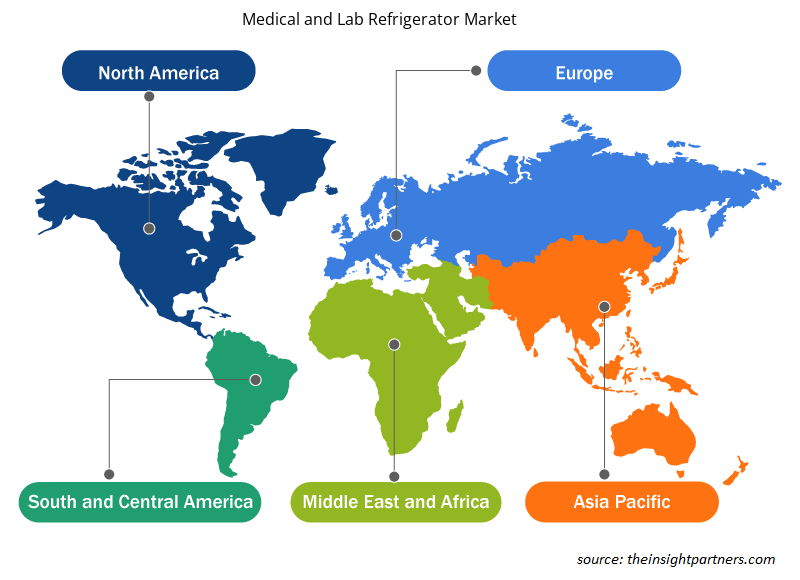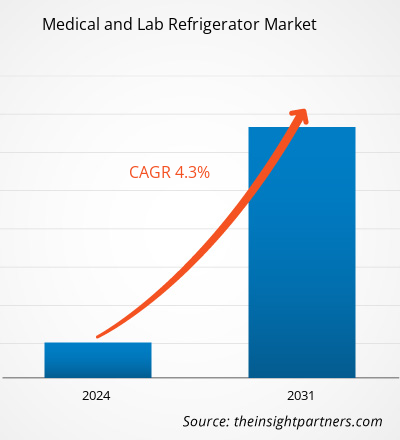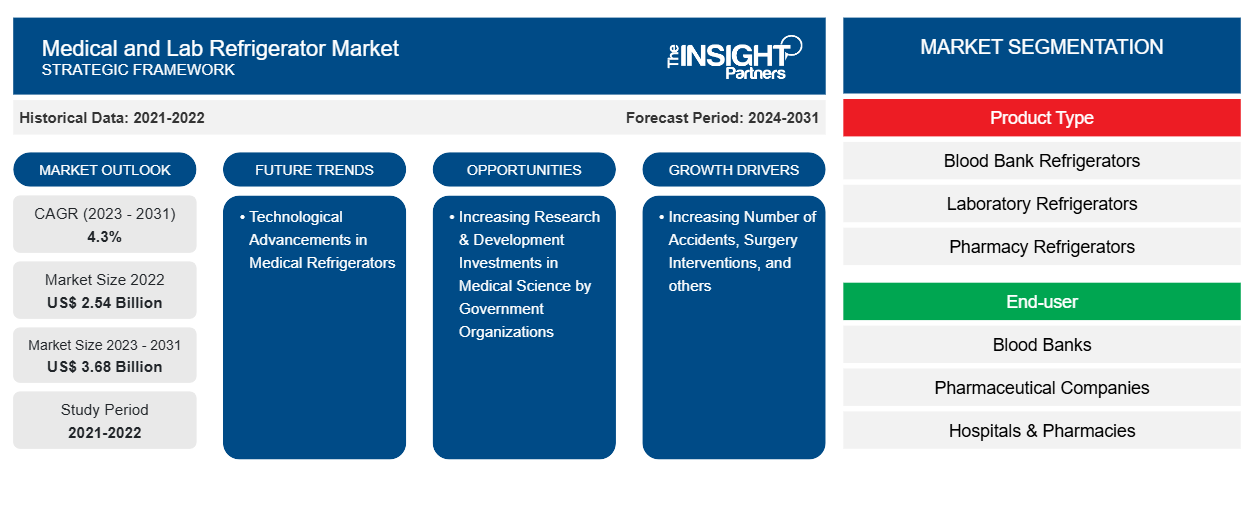Der Markt für medizinische und Laborkühlschränke wird voraussichtlich von 2,54 Milliarden US-Dollar im Jahr 2022 auf 3,68 Milliarden US-Dollar im Jahr 2031 anwachsen. Der Markt wird voraussichtlich zwischen 2023 und 2031 eine durchschnittliche jährliche Wachstumsrate von 4,3 % verzeichnen. Der technologische Fortschritt bei medizinischen und Laborkühlschränken wird wahrscheinlich weiterhin ein wichtiger Trend auf dem Markt für medizinische und Laborkühlschränke bleiben.
Marktanalyse für medizinische und Laborkühlschränke
Eine Zunahme chirurgischer Eingriffe, Traumafälle und anderer Fälle hat die Nachfrage nach Blutkomponenten erhöht, während eine Zunahme der Blutspenden die Nachfrage nach medizinischen und Laborkühlschränken erhöht hat. Darüber hinaus hat die Zunahme von Impfungen und Medikamentengebrauch die Nachfrage nach angemessenen Lagerbedingungen erhöht, was wiederum zum Marktwachstum beiträgt. Darüber hinaus hat der rasante technologische Fortschritt zur Entwicklung innovativer Produkte und zur Markteinführung neuer Produkte geführt, die das Marktwachstum vorantreiben.
Marktübersicht für medizinische und Laborkühlschränke
Die zunehmenden Forschungsaktivitäten zur Behandlung von Krankheiten, die zunehmende Häufigkeit chronischer und infektiöser Krankheiten sowie der Ersatz älterer medizinischer Kühlschränke durch neuere und fortschrittlichere energieeffiziente Kühlgeräte treiben das Wachstum des Marktes für medizinische und Laborkühlschränke in dieser Region voran. Nordamerika wird voraussichtlich den größten Marktanteil einnehmen, dicht gefolgt von Europa. Darüber hinaus wird die Nachfrage nach medizinischen und Laborkühlschränken im asiatisch-pazifischen Raum im Prognosezeitraum voraussichtlich aufgrund steigender Ausgaben für Forschung und Entwicklung sowie Entwicklungen in den Bereichen Pharmazie und Biotechnologie in lukrativem Tempo wachsen. Darüber hinaus werden Expansionsstrategien führender Marktteilnehmer im Bereich medizinischer und Laborkühlschränke das Wachstum der Branche weiter fördern. Fortschritte bei klinischen Anwendungen, Patientenblutmanagement und Verabreichung von Zelltherapien haben potenzielle Wachstumschancen für den Markt für medizinische und Laborkühlschränke geschaffen.
Passen Sie diesen Bericht Ihren Anforderungen an
Sie erhalten kostenlos individuelle Anpassungen an jedem Bericht, einschließlich Teilen dieses Berichts oder einer Analyse auf Länderebene, eines Excel-Datenpakets sowie tolle Angebote und Rabatte für Start-ups und Universitäten.
-
Holen Sie sich die wichtigsten Markttrends aus diesem Bericht.Dieses KOSTENLOSE Beispiel umfasst eine Datenanalyse von Markttrends bis hin zu Schätzungen und Prognosen.
Treiber und Chancen auf dem Markt für medizinische und Laborkühlschränke
Wachsende Nachfrage nach Blutspeicherzentren und Blutbanken begünstigt den Markt
Das Bewusstsein für Blutspenden ist gestiegen, indem Menschen über die Vorteile und Missverständnisse dieses Vorgangs aufgeklärt wurden. Dadurch werden sie aufgeschlossener und melden sich freiwillig zur Blutspende, was zu einer steigenden Nachfrage nach Blutspeicherzentren und Blutbanken führt. Darüber hinaus ist die Zahl der Blutspenden auch durch Aufklärungsinitiativen von Regierungsorganisationen und privaten Unternehmen sowie Bildungseinrichtungen gestiegen. Laut Weltgesundheitsorganisation wurden im Jahr 2023 weltweit rund 118,54 Millionen Blutspenden getätigt, davon 40 % aus Ländern mit hohem Einkommen, was 16 % der Weltbevölkerung entspricht. Das gesammelte Blut wird hauptsächlich bei chirurgischen Eingriffen, in der Allgemeinmedizin, Hämatologie und bei Blutkrankheiten sowie bei Unfällen und Notfällen verwendet, was die Nachfrage nach Blutbankkühlschränken antreibt.
Steigende Investitionen staatlicher Organisationen in Forschung und Entwicklung im Bereich der Medizin – eine Chance für medizinische Kühlschränke und Laborkühlschränke
Die staatliche Unterstützung der Entwicklung innovativer Medizinprodukte wird das Wachstum des Geschäfts weiter beschleunigen. So wurden beispielsweise in der Medizinprodukterichtlinie der Europäischen Kommission spezifische Anforderungen und Vorschriften für biomedizinische Gefrier- und Kühlschränke festgelegt, um Blut und Blutbestandteile vor der Lagerung zu schützen. Dies trägt zum Wachstum des Kühlschrankmarktes für medizinische und Laboranwendungen bei.
Laut dem National Center for Science and Engineering Statistics (NCSES) schätzen die Unternehmen, dass die Ausgaben für Forschung und Entwicklung von 2021 bis 2022 um 84,1 Milliarden US-Dollar steigen werden. Darüber hinaus investierten die Unternehmen im Jahr 2021 130 Milliarden US-Dollar in die Forschung, was 22 % der gesamten Unternehmensinvestitionen für Forschung und Entwicklung entspricht, die 49 % der gesamten US-Forschungsfinanzierung ausmachen. Im Jahr 2023 beispielsweise überstiegen die direkten medizinischen Kosten für nur sechs chronische Erkrankungen – Herzkrankheiten und Schlaganfall, Krebs, Diabetes, Zahnerkrankungen, Arthritis und Alzheimer – 1,1 Billionen US-Dollar, mehr als das Sechsfache der gesamten medizinischen und gesundheitlichen Forschungs- und Entwicklungsausgaben in diesem Jahr. Dies zeigt den wachsenden Bedarf an Investitionen in die Medizinwissenschaft. In den Vereinigten Staaten sterben jedes Jahr fast 130.000 Menschen im Alter von 45 Jahren an gesundheitlichen Gefahren, die durch höhere Investitionen in Forschung und Entwicklung besser verstanden und letztendlich verhindert werden können. Die wachsenden Investitionen in die Medizinwissenschaft bieten in den kommenden Jahren Wachstumschancen für den Markt für medizinische und Laborkühlschränke.
Segmentierungsanalyse des Marktberichts für medizinische und Laborkühlschränke
Wichtige Segmente, die zur Ableitung der Marktanalyse für medizinische und Laborkühlschränke beigetragen haben, sind Produkttyp und Endbenutzer.
- Basierend auf dem Produkttyp ist der Markt für medizinische und Laborkühlschränke in Blutbankkühlschränke, Laborkühlschränke, Apothekenkühlschränke, Enzymkühlschränke und andere unterteilt. Das Segment der Laborkühlschränke hatte im Jahr 2023 einen größeren Marktanteil.
- In Bezug auf den Endverbraucher ist der Markt in Blutbanken, Pharmaunternehmen, Krankenhäuser und Apotheken, Forschungsinstitute und andere unterteilt. Das Segment der Pharmaunternehmen dominierte den Markt im Jahr 2023.
Marktanteilsanalyse für medizinische und Laborkühlschränke nach geografischer Lage
Der geografische Umfang des Marktberichts für medizinische und Laborkühlschränke ist hauptsächlich in fünf Regionen unterteilt: Nordamerika, Asien-Pazifik, Europa, Naher Osten und Afrika sowie Süd- und Mittelamerika.
Nordamerika dominiert den Markt für medizinische und Laborkühlschränke aufgrund der zunehmenden Investitionen in Forschungsaktivitäten zur Behandlung von Krankheiten, der zunehmenden Häufigkeit von Infektions- und chronischen Krankheiten sowie des Ersatzes älterer Kühlschränke durch modernere, energieeffizientere Kühlschränke. Die vollständige Einführung medizinischer Kühlgeräte bleibt für Krankenhäuser und Apotheker eine Priorität. Darüber hinaus sind die Einhaltung gesetzlicher Vorschriften für temperaturempfindliche Medikamente und Impfstoffe sowie die Gewährleistung der Patientensicherheit normalerweise ausschlaggebend für die Investitionsentscheidung in medizinische Kühlgeräte. Behörden wie die staatlichen Gesundheitsbehörden, das CDC, die staatlichen Apothekerkammern und die Joint Commission, um nur einige zu nennen, berücksichtigen Kühlgeräte im Rahmen von Inspektionen und Audits. Dies bedeutet, dass Krankenhäuser, Labore und Apotheker die Leistung von Kühlschränken als wichtigen Aspekt berücksichtigen sollten. Der asiatisch-pazifische Raum wird in den kommenden Jahren voraussichtlich die höchste durchschnittliche jährliche Wachstumsrate aufweisen.
Regionale Einblicke in den Markt für medizinische und Laborkühlschränke
Die regionalen Trends und Faktoren, die den Markt für medizinische und Laborkühlschränke während des gesamten Prognosezeitraums beeinflussen, wurden von den Analysten von Insight Partners ausführlich erläutert. In diesem Abschnitt werden auch die Marktsegmente und die Geografie für medizinische und Laborkühlschränke in Nordamerika, Europa, im asiatisch-pazifischen Raum, im Nahen Osten und Afrika sowie in Süd- und Mittelamerika erörtert.

- Erhalten Sie regionale Daten zum Markt für medizinische und Laborkühlschränke
Umfang des Marktberichts zu medizinischen und Laborkühlschränken
| Berichtsattribut | Details |
|---|---|
| Marktgröße im Jahr 2022 | 2,54 Milliarden US-Dollar |
| Marktgröße bis 2031 | 3,68 Milliarden US-Dollar |
| Globale CAGR (2023 - 2031) | 4,3 % |
| Historische Daten | 2021-2022 |
| Prognosezeitraum | 2024–2031 |
| Abgedeckte Segmente |
Nach Produkttyp
|
| Abgedeckte Regionen und Länder |
Nordamerika
|
| Marktführer und wichtige Unternehmensprofile |
|
Marktteilnehmerdichte für medizinische und Laborkühlschränke: Auswirkungen auf die Geschäftsdynamik verstehen
Der Markt für medizinische und Laborkühlschränke wächst rasant, angetrieben durch die steigende Nachfrage der Endnutzer aufgrund von Faktoren wie sich entwickelnden Verbraucherpräferenzen, technologischen Fortschritten und einem größeren Bewusstsein für die Vorteile des Produkts. Mit steigender Nachfrage erweitern Unternehmen ihr Angebot, entwickeln Innovationen, um die Bedürfnisse der Verbraucher zu erfüllen, und nutzen neue Trends, was das Marktwachstum weiter ankurbelt.
Die Marktteilnehmerdichte bezieht sich auf die Verteilung der Firmen oder Unternehmen, die in einem bestimmten Markt oder einer bestimmten Branche tätig sind. Sie gibt an, wie viele Wettbewerber (Marktteilnehmer) in einem bestimmten Marktraum im Verhältnis zu seiner Größe oder seinem gesamten Marktwert präsent sind.
Die wichtigsten Unternehmen auf dem Markt für medizinische und Laborkühlschränke sind:
- ZhongkeMeiling Cryogenics Company Limited
- Felix Storch, Inc
- Follett LLC
- Helmer Scientific Inc
- .Haier Biomedical
- Lec Medizin
Haftungsausschluss : Die oben aufgeführten Unternehmen sind nicht in einer bestimmten Reihenfolge aufgeführt.

- Überblick über die wichtigsten Akteure auf dem Markt für Medizin- und Laborkühlschränke
Neuigkeiten und aktuelle Entwicklungen zum Markt für medizinische und Laborkühlschränke
Der Markt für medizinische und Laborkühlschränke wird durch die Erfassung qualitativer und quantitativer Daten nach Primär- und Sekundärforschung bewertet, die wichtige Unternehmensveröffentlichungen, Verbandsdaten und Datenbanken umfasst. Im Folgenden finden Sie eine Liste der Entwicklungen auf dem Markt für medizinische und Laborkühlschränke sowie Strategien:
- Das Unternehmen hat in Indien Laborkühl- und -gefriergeräte der TSV-Serie auf den Markt gebracht, die auf die Lageranforderungen von akademischen, Forschungs- und Gesundheitslaboren ausgerichtet sind. (Quelle: Healthcare Radius, Newsletter, 2023)
- Das Unternehmen brachte 22 brandneue Modelle auf den Markt, darunter 15 neue Arzneimittelkühlschränke und sieben neue biomedizinische Gefriergeräte. Jedes neue Modell wurde von Grund auf sorgfältig entwickelt, um die überlegenen Funktionen und die Zuverlässigkeit zu bieten, die für pharmazeutische und biomedizinische Anwendungen erforderlich sind, während gleichzeitig ein attraktiver Kaufpreis und niedrige laufende Betriebskosten bestehen bleiben. (Quelle: Arctiko, Pressemitteilung, 2023)
- Das Unternehmen hat neue intelligente Kühlschränke der TM TSG-Serie auf den Markt gebracht, da die Nachfrage nach sicherer und zuverlässiger Lagerung temperaturempfindlicher medizinischer Vorräte beispiellose Höhen erreicht hat, was die Einführung der Kühlschränke der TSG-Serie zu einem bedeutenden Meilenstein macht. (Quelle: Thermo Fischer Scientific, Newsletter, 2021)
Marktbericht zu Kühlschränken für medizinische Zwecke und Labors – Umfang und Ergebnisse
Der Bericht „Marktgröße und Prognose für medizinische und Laborkühlschränke (2021–2031)“ bietet eine detaillierte Analyse des Marktes, die die folgenden Bereiche abdeckt:
- Marktgröße und Prognose auf globaler, regionaler und Länderebene für alle wichtigen Marktsegmente, die im Rahmen des Projekts abgedeckt sind
- Marktdynamik wie Treiber, Beschränkungen und wichtige Chancen
- Wichtige Zukunftstrends
- Detaillierte PEST/Porters Five Forces- und SWOT-Analyse
- Globale und regionale Marktanalyse mit wichtigen Markttrends, wichtigen Akteuren, Vorschriften und aktuellen Marktentwicklungen
- Branchenlandschaft und Wettbewerbsanalyse, einschließlich Marktkonzentration, Heatmap-Analyse, prominenten Akteuren und aktuellen Entwicklungen
- Detaillierte Firmenprofile
- Historische Analyse (2 Jahre), Basisjahr, Prognose (7 Jahre) mit CAGR
- PEST- und SWOT-Analyse
- Marktgröße Wert/Volumen – Global, Regional, Land
- Branchen- und Wettbewerbslandschaft
- Excel-Datensatz
Aktuelle Berichte
Verwandte Berichte
Erfahrungsberichte
Grund zum Kauf
- Fundierte Entscheidungsfindung
- Marktdynamik verstehen
- Wettbewerbsanalyse
- Kundeneinblicke
- Marktprognosen
- Risikominimierung
- Strategische Planung
- Investitionsbegründung
- Identifizierung neuer Märkte
- Verbesserung von Marketingstrategien
- Steigerung der Betriebseffizienz
- Anpassung an regulatorische Trends























 Kostenlose Probe anfordern für - Markt für medizinische und Laborkühlschränke
Kostenlose Probe anfordern für - Markt für medizinische und Laborkühlschränke